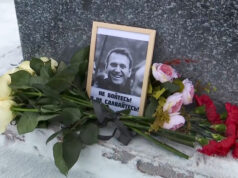The Ukrainian crisis bears many similarities to the Cold War. Once again, Russian tanks have rolled across an international border. Central and Eastern European countries openly fear Moscow’s revanchist and imperial foreign policy. The North Atlantic Treaty Organization, long ago prophesied to go “out of area or out of business,” has found new purpose deterring an old adversary. Leaders in Moscow, Brussels, and Washington warn of an ideological conflict between East and West. And, in what must instill a sense of déjà vu among students of Cold War esoterica, the once-obscure term “Finlandization” is now being bruited about.
Usually intended as a pejorative, “Finlandization” derives from the posture of neutrality that Finland adopted during the Cold War. In exchange for not joining NATO and other Western institutions such as the European Economic Community (forebear to the European Union), Finland enjoyed a degree of freedom unknown to the Soviet republics or communist satellite states. Defenders of the policy insist that it allowed Finland, a nation of just five million people sharing an 800-mile long border with Russia, to survive as a prosperous, free, and democratic country with a market economy and elected parliament, all the while maintaining good relations with both the Moscow and the West.
Decades after the term achieved seeming obsolescence, “Finlandization” is making a comeback as a proposed remedy for Ukraine. Over the past few months, no less than three foreign policy wise men have recommended the Finnish model for Ukraine: former National Security Advisor Zbigniew Brzezinski, former Secretary of State Henry Kissinger, and Washington Post columnist David Ignatius. NATO membership for Ukraine, they argue, is unnecessary, and Moscow would view it as “provocative.” Kiev should instead pronounce its neutrality in return for a security guarantee from Moscow. Twenty years ago, Kiev signed just such a guarantee (the Budapest Memorandum), giving up its sizeable nuclear weapons arsenal only to see Russia blatantly violate the agreement with its annexation of Crimea and ongoing support for violent separatists. Understandably, Ukrainians are less sanguine about Russian promises than are Western advocates of nonalignment.
Misreading History
Recommending Finlandization for Ukraine is bad advice on several levels. First, it misunderstands and misinterprets Finland’s experience, either downplaying or outright ignoring the costs that this policy imposed upon the country’s democracy. Proponents of Finlandization discount the danger that it posed to the European continent as a potential model for other countries susceptible to Russian pressure and influence. Furthermore, compelling neutrality upon an unwilling Ukraine is a stark moral capitulation to foreign aggression. Foreclosing the possibility of EU and NATO membership to Ukraine would shred the basic precepts of Europe’s post-Cold War security architecture, enshrined in agreements stipulating that countries be allowed to choose their own political and security alliances free from foreign intimidation and threats.
A former duchy of the Czarist Empire, Finland won its independence in December 1917 amid the chaos of the Bolshevik revolution. Twice during World War II, Finland fought off Soviet incursions into its territory, losing 100,000 men and 10 percent of its territory but ultimately maintaining independence. Through this massive sacrifice, Finland staved off the fate that would later befall every other country that bordered Russia.
In 1948, Helsinki signed a “Treaty of Friendship, Cooperation, and Mutual Assistance” with Moscow that would set the terms of Finlandization over the ensuing decades. Though the agreement recognized Finland’s existence as an “independent state,” it also mandated military cooperation between the Soviet Union and Finland should NATO attempt to invade the Soviet Union or Finland through Finnish territory. Even before this treaty was signed, Finland proved its deference to the Soviets by refusing much-needed Marshall Plan aid, following the lead of other countries in the Eastern Bloc that faced more concrete forms of Russian pressure.
The treaty laid the basis for the “Paasikivi-Kekkonen line,” named after Finnish Presidents Juho Paasikivi and his successor, Urho Kekkonen, which sought above all to keep Finland neutral in international affairs. Kekkonen, who served as President from 1956 to 1982 and with whom the policy of Finlandization is most closely associated, went to great, and at times surreptitious and autocratic, lengths to preserve this policy. By the time he resigned, Kekkonen had served as President for 26 consecutive years, and would have likely ruled even longer had poor health not forced him to step down. For his efforts, Kekkonen was awarded the Lenin Peace Prize, the only Western leader to be garlanded in such fashion.
Finnish “neutrality” meant turning a blind eye to Soviet imperialism and, occasionally, actively furthering Soviet interests in northern Europe. Finland did not join the majority of countries at the United Nations that denounced the Soviet invasion of Hungary in 1956. Likewise, the Finns remained silent during the 1968 Warsaw Pact invasion of Czechoslovakia. In 1952, when he was Prime Minister, Kekkonen delivered a speech implicitly calling on Norway and Denmark to leave NATO, creating the “neutral” Scandinavian zone that had long been a major aim of Soviet foreign policy, the easier by which to Finlandize it.
Another manifestation of pernicious Soviet influence could be found in censorship, both official and informal, of the press and culture. The Finnish government invoked the preemptive right to censor any material that could “damage or jeopardize relations with a foreign power.” The government rarely had to exercise this power, however, as the Finnish press, willingly and shamefully, bowdlerized itself. A culture of self-censorship quickly took hold over the country’s media, and not-so-subtle threats from Kekkonen and other leading politicians instructing journalists to report “responsibly” about the Soviet Union meant that nary a critical word of that country or its allies could be found in Finnish newspapers or heard on Finnish television and radio. Almost 2,000 books were banned over the course of the Finlandization era, as were films ranging from Dr. Strangelove and The Manchurian Candidate to Renny Harlin’s 1986 blood-splattered action flick Born American, which followed the fate of three American adventurers vacationing in Finland who mistakenly cross the border into the Soviet Union (a 2008 book revealed that Harlin’s film was banned at the express request of the Soviet Ambassador). No Finnish publisher would release Alexander Solzhenitsyn’s Gulag Archipelago. (Copies of the Finnish translation had to be imported from a Swedish publishing house.) Not for nothing did the Finnish satirist Kari Suomalainen define Finlandization as “the art of bowing to the East so carefully that it could not be considered mooning the West.”
A High Cost
Today’s proponents of Finlandization write as if all it entails is foreign policy neutrality; they have either forgotten or are completely unaware that it also involved frequent and substantive Soviet meddling in Finland’s domestic affairs and would entail constraining Kiev’s sovereignty beyond a mere formal commitment not to join certain multilateral organizations. For example, Brzezinski proposes Finlandization in the same breath as he calls for the West to make clear that “overt or covert Russian participation in its neighbor’s domestic conflicts” would carry a high diplomatic and economic price for Moscow, an assertion that betrays ignorance of how the two are mutually exclusive.
Were the proposed Finlandization of Ukraine limited to its foreign policy—that is, a formal commitment to stay out of NATO and the European Union—then it might be a compromise acceptable to the majority of Ukrainians. To be sure, such concessions would, on their face, violate the spirit of the Charter of Paris for a New Europe, the 1990 agreement signed by the Soviet Union that “fully recognize[s] the freedom of States to choose their own security arrangements.” Nonetheless, one might argue that, as with Finland during the Cold War, staying out of Western multilateral organizations and embracing a neutralist foreign policy is the most “realistic” option, a reasonable price to for a small and weak country with a big and aggressive neighbor to pay.
But the more one understands the history of Finlandization and grasps the Kremlin’s present-day agenda, the less “realistic” this option becomes. Putting aside Ukraine’s need for rock-solid security guarantees in light of Russian actions (the sort of guarantee that only can be found in Article VI of the NATO Charter), not to mention Russia’s history of blatantly ignoring the security commitments it has already signed, the most deleterious effect of swearing off Western integration would be on Ukraine’s internal development. For the past 25 years, the lure of European integration has been the greatest incentive for liberalizing the countries of Central and Eastern Europe. The prospect of EU membership helped transform governments making the transition from corrupt, sclerotic, controlled systems to open, liberal societies that value the rule of law and Human Rights. Viewed in this light, any sort of Finlandization scheme would be disastrous for Ukraine’s future aspirations as a healthy, Western European-style democracy.
A policy that offered Russia veto power over the composition of Ukrainian governments would mean the inevitable corrosion of honest administration, democratic practice, individual liberties, and an open market economy. For Ukraine, it would mean maintaining the sort of oligarchic system that has doomed it for the past 25 years. In spite of its many shortcomings, Finnish democracy under Finlandization was resilient enough, and its society sufficiently cohesive, to withstand the pressures of Soviet hegemony and their resultant debasements. Finland emerged from the Cold War era intact as a Western democracy. Ukraine, on the other hand, given its massively corrupt political culture, regional divides, and easily manipulated ethno-linguistic differences, is one of the worst possible candidates for Finlandization. Forcing such an arrangement on Ukraine would effectively surrender the country to the Russian sphere of influence.
There is also the moral case against Finlandization. That there is even debate over whether or not this is a suitable model for Ukraine is indicative of a paternalistic attitude on the part of Western observers, who speak as if the fate of this country were theirs to dictate. It should go without saying that Ukraine’s future ought to be for Ukrainians to decide, not armchair observers of international politics. Finlandization would contravene the express wishes of the Ukrainian people, who demonstrated their overwhelming preference for a European future in May’s presidential election, in which more than 80 percent of the voters supported pro-Western candidates.
Indeed, if Finlandization were such a success, one might expect the Finns to be at the forefront of those pushing it on the Ukrainians. Yet it is difficult to find anyone in Finland suggesting that Ukraine follow its example. Soon after the collapse of the Soviet Union, Finland immediately began wresting itself out of the Finlandization straightjacket. It made a mad dash for EU membership, formally joining the organization in 1995. And while opposition to NATO membership has usually enjoyed support from a plurality of Finns over the past 25 years, the annexation of Crimea has turned the debate on its head; immediately after taking office, the country’s new Prime Minister said the country ought to have joined the alliance back when it entered the European Union nearly two decades ago.
Not a Solution
Finlandization was unique to its time and place. Finland has an obscure, homogenous, non-Slavic culture and language that had long resisted Russian domination. Ukraine, meanwhile, has deep historic, cultural, and linguistic ties to Russia that would make its resistance to Russian political and military subjugation next to impossible were it not for the strong, external pull of the West. A Finlandized Ukraine would therefore be significantly less independent, democratic, and prosperous than Finland was during the Cold War period.
The Soviets upheld Finland as a model for their relations with non-communist countries for a reason: A compliant, politically neutral government in Helsinki—one that censored its press for any negative comments about the Soviet Union or its communist allies, returned escaped dissidents, and traded on terms favorable to Moscow—was the next best thing to having one-party communist rule à la Poland or East Germany. That all this could be achieved without having to station a single Soviet soldier in the country made it all the more attractive to Moscow.
During the years of détente, when political movements across Western Europe were calling for unilateral disarmament and the dissolution of NATO, there was real fear of what the “specter of Finlandization,” posed for the continent. Today, the signs of creeping Finlandization across Europe are abundant. With the rising popularity of anti-EU parties (some of which enjoy warm relations with, if not actual monetary assistance from, Moscow), a plurality of Germans favoring neutralism over the Western alliance, and the City of London effectively an oblast of the Russian Federation, sacrificing Ukraine on the altar of better relations with Moscow would reinforce a disquieting trend. Relinquishing Ukraine to this fate amounts to a massive strategic and moral failure on the part of the West.
Nor would it repair relations with Moscow. For the Kremlin’s appetite will not be satisfied by a Finlandized Ukraine; it will next demand similar arrangements for all the countries in its “near abroad.” A relic of the Cold War, Finlandization was an unfortunate overreaction to Soviet aggression. And like the expansionist communist ideology that provoked it, so to the dustbin of history should Finlandization also be consigned. Far from being the scrappy strategy of fond memory, Finlandization was a kind of imperialism. Our foreign policy mandarins ought to study what exactly it was, the costs it entailed, and the threat it posed to the Western democracies before so casually wishing it upon others.
James Kirchick is a fellow with the Foreign Policy Initiative. A longer version of this piece originally appeared on the website of The American Interest.





